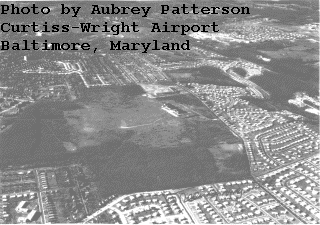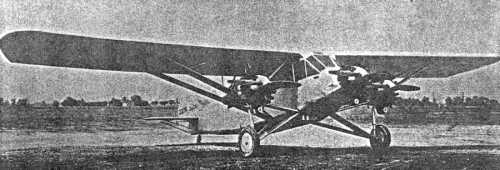CURTISS-WRIGHT
AIRPORT, BALTIMORE, MARYLAND
The Curtiss-Wright company got the urge to
build airports after Lindbergh created a stir
in the public’s mind with his Paris flight.
Lindbergh's story is
aviation history. Lindbergh's flight was also a resounding success for the
Wright Aeronautical company. Their dependable new Whirlwind engine never missed
a beat. Lindbergh's feat made the J-5C the most popular engine for long
distance air travel for years to come. Soon more flights were made to Europe,
to the North and South poles and across the Pacific using Wright Whirlwind
power.
As
a result of the successes of the Wright brothers and Glenn Curtiss the
Curtiss-Wright Corporation was formed when 12 Wright and Curtiss affiliated
companies merged on July 5, 1929. On August 22nd of that same year,
Curtiss-Wright Corporation was listed on the New York Stock Exchange where it
still trades today.
Researching
Curtiss-Wright Airport, Baltimore, Maryland, led to some interesting
discoveries. First of all, the
grand-daddy of all knowledge, Smithsonian Institution National Air And Space
Museum, had very little information.
Mr. Ralph
Strong, Archives Reference Team, from the Smithsonian wrote a nice letter and
provided information quoted below from Baltimore Magazine, November 1941.
“In addition
to the Municipal Airport, Logan Field, and the Glenn L. Martin Airport,
Baltimore has two private airfields.
One is the million dollar Curtiss‑Wright Airport at Green Spring
and Smith Avenues, work upon which started in
1929. It contains 270 acres, and is equipped with hangers and
other necessary buildings. The beginnings of this airport stem back
to Logan Field where, in 1919, the Chesapeake Aircraft Corporation was organized. It is the City's largest private flying center. Col. W. D. Tipton, now recalled to active army service, controls the field under lease. Both the field and its school, Baltimore School of Aeronautics, Inc., are in charge of chief pilot Lester J. Sipe and W. E. Mainville is business manager.”
Mr. Strong’s letter added, “We do not have a photograph of this facility
in our files.” I was fortunate enough
to meet Aubrey (Pat) Patterson who did have a photograph, and was active at
Curtiss-Wright as a parachutist. He
granted me an interview and gave me a copy of the picture.
Pat Patterson is still active as an aerial
photographer and parachute rigger. He
lives near Baltimore-Washington International Airport.
In Pat’s
basement there is a forty-foot extension to the room that accommodates a chute
fully stretched out. He has two or
three very old, Singer-type sewing machines.
One does zigzag stitching. He
says he only repairs chutes; does not design and produce original
creations. An older, lighter weight
machine is a Wheeler-Wilson.
He may have
sewing machines that deserve to be in the Smithsonian themselves, but perhaps
not. Pat says it takes about twenty-six
types of sewing machines to put an original parachute together.
Pat started
flying in Pennsylvania while still in college and came to work at the Glenn L.
Martin plant in Baltimore just before World War II. He said he decided parachuting would get him in the air, since
the cost of renting and owning an airplane was outside his budget.
In February
1941, Pat visited Logan Field to consider the prospects of jumping out of
there. They had four very active flight
schools at the time. He inquired about
parachuting and was told that a man named Eddie Butler was doing some at
Curtiss-Wright Airport. Pat discovered
Mr. Butler lived near him in Middle River, and got invited out to
Curtiss-Wright to look the operation over.
Pat got his
parachute experience in 1939 while working at the Eagle Parachute Company at
Lancaster, Pennsylvania while attending Franklin and Marshall College
there. His first jump was in August
1939.
Pat was
interested in aeronautical engineering and wanted to attend the Massachusetts
Institute of Technology, but those were the Depression years. Sometimes dreams got deferred, for a very long
time. He felt very fortunate to attend
Franklin and Marshall, through the good graces of his mother’s friend following
high school graduation in 1936.
Pat Patterson
remembers the Curtiss-Wright company got the urge to build airports after
Lindbergh created a stir in the public’s mind with his Paris flight. They built one in Cuyahoga County, Ohio,
east of Cleveland, in addition to this field at Baltimore. The hangars in particular were distinctively
a Curtiss-Wright innovation. It seemed
a good idea at the time, build airports around the country to standard
specifications, a long time before Federal Air Regulations came along and set
standards for all to follow.
Pat learned
to fly at Cuyahoga County, Ohio, while working for the Glenn L. Martin Company. Then the field was closed during World War
II. He always knew it would be one of
the airports that reopened for business and would survive post-war expansion.
Les Sipe, the
manager mentioned in the Baltimore Magazine article, was well-known to Pat while
he was jumping at Curtiss-Wright. Sipe
was running the College Pilot Training program, well-remembered by many pilots
as “CPT” before World War II came along.
Wars destroy many things and upset dreams. A lot of the airports were closed during that era and did not reopen. Finding people who remember them is an interesting pursuit. Pilots like Pat Patterson make the tasking interesting and educational.
Curtiss-Wright Airport consisted of a total of 260 acres,
with a
4,000’ x 4,000’ irregularly shaped grass landing area.
Two 100’
x 120’ hangars sat at the north end of the field.
They were
concrete-block hangars in the Art-Deco style.
On the
airfield side each hangar had rows of large windows,
set in a single-story
projection that was flanked by two-story sections. The owner was listed as
Baltimore Air Terminals, Inc. (with a New York address, ironically!), and the
operator was listed as Curtiss Airports Corporation. The Flying Club of Baltimore was listed as using the field.
Behind the excitement at Curtiss-Wright Airport was Colonel William
Tipton, who leased and ran the facility during its heyday. A World War One ace
pilot he was a flying club president and a columnist on aviation topics. Curtiss-Wright Airport was an excellent
stage for his promotion of air-mindedness; however it lacked the space to
become the air transportation hub he may have envisioned, and seems not to have
been particularly profitable as a business venture.
The Airport Directory Company’s 1937 Airports Directory (courtesy of Bob Rambo)described Curtiss-Wright Field as having three
grass landing strips, with the longest being 3,000 feet.
The
aerial photo in the directory depicted two hangars on the field.
Curtiss-Wright was Baltimore’s largest private flying center by
1941. Both the field and its school,
the Baltimore School of Aeronautics, were managed by chief pilot Lester J Sipe.
At one
point Curtiss-Wright field had many yellow Piper or Taylorcraft Cubs on the
flight line. Among the many aircraft based there was a high wing Stinson
Tri-Motor. It ended its days crashing into a tree just beyond the borders of
the airfield.

After World War Two Bendix Aviation utilized the field for radar &
electronics work, with radar antennae visible from Smith Avenue, Baltimore,
Maryland. After Bendix left, the old
airfield was abandoned for some years.
By 1958-1960, the place was a ghost town, with empty hangars. There was
a large wall map of the world in what appeared to have been an Pilots Operations
room.
Photographs published by a local weekly in January 1963 showed the
hangars were still basically intact; however, the article pointed out that a
retail complex was proposed for the property.
In the early 1960s the property underwent development
and
evolved from an airport to the Pickwick Apartments and the Smith Avenue
shopping center.